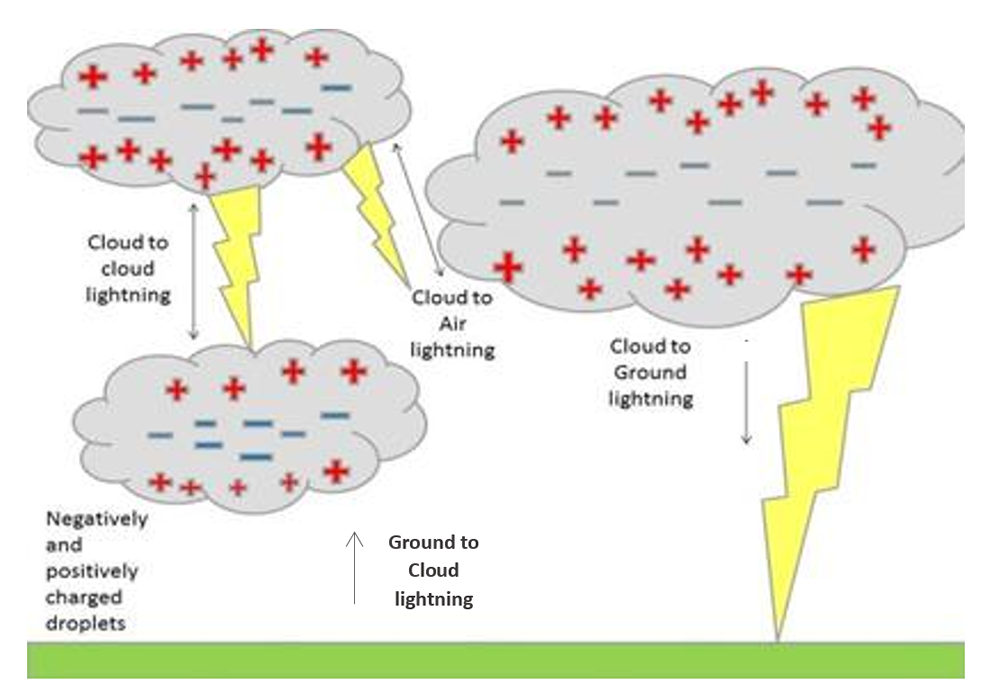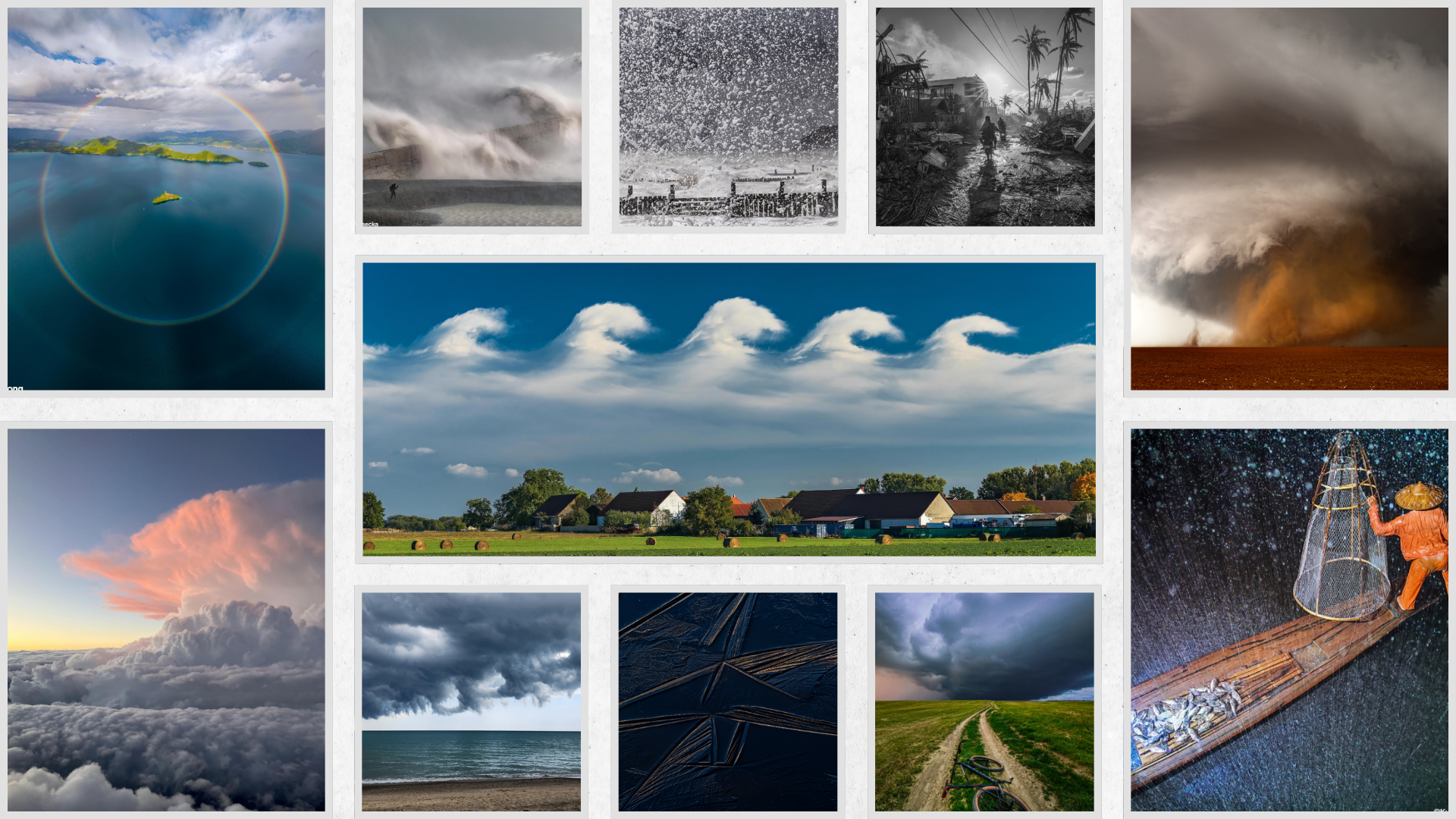

Types of Lightning
A beautiful and deadly natural phenomenon, lightning is simply a sudden, electrostatic discharge - a ‘spark’ or ‘flash’ as charged atmospheric regions temporarily equalise themselves through this discharge. The polarity of lightning discharge can affect how it spreads and branches in space and time. This, as well as its starting and ending points and direction of movement, give rise to different ‘types’ of lightning. Lightning can strike the ground, the air, or inside clouds, but there are roughly 5 to 10 times more cloud flashes than cloud-to-ground flashes.

Cloud-to-Ground (CG) Lightning
In CG lightning, a channel of negative charge, called a stepped leader, will zigzag downward in a ‘forked’ pattern - hence it is sometimes called forked lightning. This stepped leader is invisible to the human eye and travels to the ground in a millisecond. As it nears the ground, the negatively charged stepped leader is attracted to a channel of positive charge reaching up, a streamer, usually through something tall, such as a tree, house, or telephone pole. When the oppositely-charged leader and streamer connect, a powerful electrical current begins flowing (hence why it is ill-advised to stand under a tall object during a thunderstorm!). A return stroke (the very bright visible flash that we see as lightning) travels at about 60,000 miles per second back towards the cloud, with one flash consisting of as many as 20 return strokes.
Negative Cloud-to-Ground Lightning (-CG)
A downward-moving initiates the most common CG flashes, negatively-charged stepped leader, followed by an upward travelling return stroke. The net effect of this flash is to lower negative charge from the cloud to the ground. Negative CG lightning strikes can be identified by their distinctive downward branching.

Positive Cloud-to-Ground Lightning (+CG)
A downward-moving initiates the less common CG flashes, positively-charged stepped leader, followed by an upward travelling return stroke that lowers the positive charge to earth. Such lightning is usually associated with supercell thunderstorms and trailing stratiform precipitation regions behind squall lines. Positive cloud-to-ground lightning strikes are typically very bright (relative to other lightning activity) and can be identified by their distinct lack of branching near the ground. Thunder from such lightning is very loud and may sound like a series of deep, low-frequency sonic booms. Sprites (see side box) are usually associated with more intense positive CGs.
Cloud-to-Air (CA) Lightning
This refers to a discharge that jumps from a cloud into clear air and terminates abruptly – indeed, CG lightning contains CA lightning via the branches that extend from the main channel into the mid-air. However, the most dramatic examples occur when long, bright lightning channels extend from the sides of cumulonimbus clouds.
Ground-to-Cloud (GC) Lightning
An upward-moving leader initiates a discharge between cloud and ground from an object on the ground. Ground-to-Cloud lightning strikes - sometimes called upward-moving lightning - are common on tall towers and skyscrapers. GC lightning can also be either positive or negative in polarity. Lightning that demonstrates upward branching indicates a ground-to-cloud flash, though some upward-moving lightning is branchless below the cloud base.
Intracloud (IC) Lightning
This is the most common type of discharge and refers to lightning embedded within a single storm cloud, which jumps between different charge regions in the cloud.
Sheet Lightning is a term used to describe clouds illuminated by a lightning discharge where the actual lightning channel is either inside the clouds or below the horizon (i.e. not visible to the observer). Although often associated with IC lightning, it is any lightning hidden by clouds or terrain aside from the flash of light it produces.
A related term, heat lightning, is any lightning or lightning-induced illumination too far away for thunder to be heard. Heat lightning got its name because it is often seen on hot summer nights when thunderstorms are common.
Cloud-to-Cloud (CC) Lightning (or intercloud lightning)
Although rare, lightning can also travel from one cloud to another (or more!). Spider lightning refers to long, horizontal moving flashes often seen on the underside of stratiform clouds. (Not to be confused with intracloud lightning within a single cloud).

Lightning in the UK
The most spectacular displays of lightning in the UK are generally associated with “Spanish Plume” type events, especially since these can occur during the night. These thunderstorms tend to produce significant lightning due in part to their high cloud bases, which increase the amount of water in ice form, necessary for strong electrical charging. These high cloud base storms tend to have greater IC flashes.
Winter storms usually produce the greatest proportion of CG flashes in the UK. This is because lightning-producing clouds are associated with active cold and occluded fronts. Still, many are also embedded in the polar maritime air mass afterwards (the typical wintry showers which affect the country’s western half, producing soft hail) and marked on the synoptic charts as troughs. Given that the relatively warm sea is the source of instability, these showers can be present day and night and produce infrequent but very powerful CG flashes of up to ~300,000 amps! (typical lightning is ~20kA). Their bias towards powerful CG flashes is thought to be due to their sheared, low cloud tops. The positive charge at the top of these clouds overhangs the lower negative charge, which would otherwise screen the upper charge from the ground, encouraging a direct, powerful lightning flash between the top of the cloud and the ground.
Sprites, jets and other types of lightning
Sprites are electrical discharges that occur high above active thunderstorms. Sprites appear as vertical red columns extending up to 60 miles from the cloud top and have been found to occur in conjunction with and/or as a reaction to +CG lightning. Sprites are mostly red, faintly lit (thus only visible at night), and only last a few seconds, making them nearly invisible to the naked eye and difficult to photograph. Their shape has been described as resembling columns, carrots or jellyfish!
Blue jets emerge from the top of the thundercloud, extending up in narrow cones fanning out and disappearing at heights of 25-35 miles. Blue jets last just a fraction of a second.
Elves are rapidly expanding disk-shaped glowing regions up to 300 miles in diameter. They last less than a thousandth of a second and occur above areas of active CG lightning. Scientists believe elves result when an energetic electromagnetic pulse extends up into the ionosphere.
Anvil Crawlers are tree-like, horizontally-moving IC lightning discharges which tend to appear along the underside of thunderstorm anvils. The human eye can see them due to their slower speed (relative to other lightning!). This type of lightning (sometimes referred to as ‘rocket lightning’) often covers large distances, resulting in spectacular sky-filling displays. Anvil crawlers are often very high-altitude events and typically result in soft, rolling thunder due to their great distance from the observer. Anvil crawlers can occur independently or entirely within the cloud or in connection with a cloud-to-ground discharge.
A bolt from the blue (sometimes called ‘anvil lightning’ or ‘anvil-to-ground’ lightning) is a name given to a cloud-to-ground lightning discharge that strikes far away from its parent thunderstorm. It typically originates in the highest regions of a cumulonimbus cloud, travelling a good distance horizontally away from the thunderstorm before making a vertical descent to earth. Due to the final strike point being up to 10 miles away from the storm, these lightning events can occur at locations with clear ‘blue’ skies overhead - hence the name. Indeed, this is the origin of the term describing something unexpected: ‘out of the blue’!
Bead Lightning is the name given to the decaying stage of a lightning channel, which cools after a return stroke, and its luminosity breaks up into segments. It describes a stage of a normal lightning discharge rather than a type of lightning.
Ribbon Lightning occurs in thunderstorms with high cross winds and many return strokes. The wind blows each successive return stroke sideways into the previous return stroke, causing a ribbon effect (Camera movement during the capture of a lightning photograph can also result in the same effect).
Staccato lightning is a CG lightning strike, a short-duration stroke that often appears as a single very bright flash with considerable branching.
And finally, what is ball lightning...?!
Want to track live lightning strikes across the world? Check out this link.





